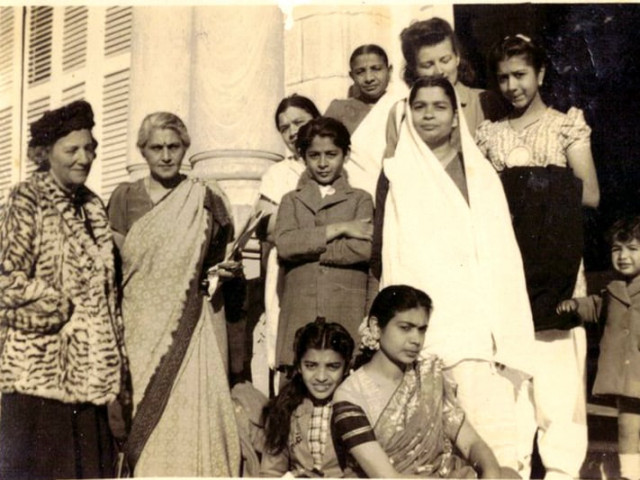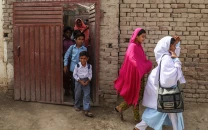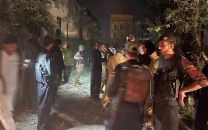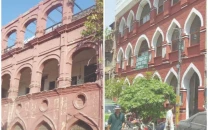Sindhi Hindu family’s heritage home in Hyderabad rescued from time
After half a century, the government plans to reopen the site as a museum.

This story starts in Hawai’i and ends in Hyderabad, spans half a century, includes a death threat and arson, 27 heirs, Rs28 million and a happy ending. (Jawaharlal Nehru makes an appearance too, although in passing.)
This December, if all goes according to plan, 79-year-old Indru Watumull will travel from her home in Hawai’i to see her family home in Hyderabad, Mukhi House, whose building has been 95% restored after five decades of abandonment. “Every time I hear[d] of something happening in Pakistan [over the years], I’d wonder what’s happened to Mukhi House,” she told The Express Tribune at her home this summer.
Mukhi House was built in 1920 by prominent Hyderabad figure Mukhi Jethanand (see box). “Mukhi wanted a real palace,” explains Kaleemullah Lashari of the antiquities department and the one-man army who has been working for five years to restore it. Indeed, one of the Mukhi family daughters, Dharam, who has incredibly sharp memories of the place even at 95 years of age, refers to it as ‘Mukhi Palace’ and not ‘house’ as the plaque says outside.
Unfortunately, Lashari’s searches of municipal archives and interviews with the family did not yield an architect’s name. But this much is clear: The house had all the trappings of a palace. It was built in the Renaissance style, but has strong influences from art deco in the form of murals, art nouveau via the stained glass windows and the Classical in the shape of its columns. And it looks magnificent.
All Lashari had were 16 photographs to painstakingly recreate its interior. The house had been through rough treatment that coincided with the exodus of Hindus after Partition. When Mukhi Jethanand died in 1927, he left the house to his widow and two sons. In 1957, however, the family left as they were given reason to believe that they would be attacked. “One of the fellows who was interested in their agricultural land in Matiari [was behind this],” explains Lashari. The haris were used to spread the rumour that their lives were in danger.
The abandoned house was occupied by revenue and evacuee officers who set up shop there. At one point, thugs from a political party set fire to it thrice in a bid to take it over. Paramilitary Rangers were deputed to protect the site but this didn’t work out well either. “They started abusing the building,” recounts Lashari. “They would rip out a window frame and use the wood for fires during the cold.”

After the Rangers, the house was given over to the Khadija Girls High School. It was at this point that Lashari intervened. The school was relocated, prompting a slew of lawsuits. But after laying the groundwork for two years, the physical restoration began in 2009 and is largely complete today.
Lashari roped in trainees from the Benazir Bhutto Youth Support Programme who learnt about heritage and preservation in the process. They washed away many layers of paint slowly and gently to reveal traces of the murals and frescos. They recreated the designs by tracing them and then a master artisan completed the job. On Sunday, Lashari received a two-year extension on the project, whose second phase includes acquiring material, documents, artifacts and gadgets to create the Museum of Recent Past. He has just sent off an invitation letter to Indru Watumull to come to Pakistan and is excited to meet her for the first time after having been in touch over email. “[Her memories] will be very vital evidence in recreating the atmosphere [for us],” he told The Express Tribune on Monday.
Mukhi Jethanand’s 27 heirs, who include his brother Mukhi Gobindaram’s children, such as Indru, have given permission for the house to be opened as a museum to the public on the condition that if the government tries to take it over and use it for any other purpose, they will take it back.
When Indru Watumull returns in a month or so, she will be flooded with memories from when she was 13 years old. When it used to rain they’d return from school (St Bonaventure’s in her case) and have fun on the marble floors on the open verandas. “They became slippery and you’d slip and slide!” She will find the floors just the same today. The verandah too where they would sleep on rolled-out mattresses when it was too hot. She will be able to walk their length and remember how poppadams were laid out to dry there. As a child her job was to change their sides after an hour.
Perhaps her memories of the parties with butlers, huge pots of biryani and a year’s supply of rosewater will help Lashari add material to the museum. She even recalls how Nehru once visited, as a faded photograph proves. And then, there were the beautiful Muslim women who would come in their burqas for the parties, but once they took them off in the women’s section, would emerge bejeweled and breathtaking. Perhaps she will leave behind memories for many more future generations to carry forward.
Published in The Express Tribune, November 27th, 2012.



















COMMENTS
Comments are moderated and generally will be posted if they are on-topic and not abusive.
For more information, please see our Comments FAQ